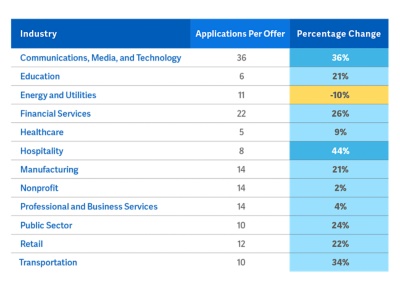Global Workforce Report: Top Talent Is Hard to Find, Harder to Keep
Uncover how to attract, retain, and empower top talent in what’s becoming an employer’s market flooded with job applications.

Uncover how to attract, retain, and empower top talent in what’s becoming an employer’s market flooded with job applications.

In this article we discuss:
The job market is evolving rapidly. And while hiring is picking up, insights from the Workday platform and a study we conducted with Hanover Research indicate that this is an employer’s job market.
But that doesn’t come without challenges. The sheer volume of applications means that top talent is hard to find in a sea of candidates, and now with early signals that high-potential employees are starting to leave, top talent will be even harder to keep.
Job applications grew four times faster than requisitions in the first half of 2024. With the pace of applications outpacing hiring demand, it’s clear that employers have more choices and employees have fewer in this candidate-dense market. This situation will become more pronounced if the job growth continues to slow down and unemployment keeps edging up both in the U.S. and globally.
Employees who believe they are doing meaningful work feel 37% more accomplished than those who don’t, even under workloads workers describe as “challenging.”
In the chart below, note how only one industry is seeing fewer applications per job offer:

We also found that employers have raised experience requirements, with 59% of our study respondents saying this trend is likely to continue over the next 12 months. This stands to exacerbate the issue, making it even harder for job seekers to find jobs.
Bottom line, we found:
Hiring is up but so are the stakes. Job openings have increased, and applications are flooding in. With this expanding applicant pool, employers are raising the bar by demanding more experience and qualifications. This makes it tougher for job seekers, especially those switching careers.
Top performers are on the move. In a surprising twist, given the current hiring environment and the fact that overall voluntary attrition is low, 75% of industries report increased turnover among high-potential employees. This means companies need to be extra vigilant about retaining their star players.
Meaningful work is non-negotiable. Employees aren’t just looking for a paycheck. They want to feel like their work matters. In fact, workers who believe they are doing meaningful work feel 37% more accomplished than those who don’t, even under workloads workers describe as “challenging.”
Internal mobility is a win-win. Providing growth opportunities within your organization not only boosts employee satisfaction, but it also helps you retain valuable skills and knowledge.
In a surprising twist, given the current hiring environment and the fact that overall voluntary attrition is low, 75% of industries report increased turnover among high-potential employees.
What can business leaders do? We go deeper in the report but big picture, employers should:
Rebuild trust through transparency. Employers don’t just owe workers clear direction; they also need to explain the “why” behind their asks. For example, if having a high-performing culture is an expectation, measure it and make that data available to individuals, teams, and leaders—it’s easier for everyone to align to a goal if they are all looking at the same information.
Make work meaningful. Remove the barriers to getting good work accomplished—such as useless meetings, cumbersome processes, and limited autonomy. And then, related to rebuilding trust through transparency above, make sure every employee knows how they are contributing to the company’s goals.
Personalize your employee experience efforts based on tenure. Evolve your employee experience to adapt to changing employee wants and needs; as a result, you’ll see big dividends in employee retention and productivity.
Embrace AI strategically. AI can help recruiters optimize hiring, uncover hidden talent, and facilitate internal mobility. What’s more, organizations can use AI to improve workflows, make it easier for managers to manage schedules, and help employees find the information they need—whether that’s summarizing a long conversation or quickly finding answers to pay and benefits questions. When it comes to using AI for hiring, as shown in the table below, adoption is still in the early stages.

The world of work is evolving, and there’s a collective recognition that we need to find a center that’s stable. We also need to reach a point where businesses can achieve the results they need and workers can get the support they need to excel, even under occasional heavy workloads
To thrive, companies must prioritize employee needs and foster a culture of trust and growth. By focusing on these key areas, you can build a resilient, engaged, and high-performing workforce ready to navigate the future.
Download Workday Global Workforce Report: Restoring Trust Before Your Top People Leave (formerly Workday Hiring and Talent Trends) to better understand how engagement drivers change with tenure and how business leaders are looking at hiring and talent. You’ll also find snapshots of the hiring environment by industry and by country.
More Reading


DevCon 2025 celebrated community, innovation, and forward-thinking development. Discover how the Workday developer community is shaping the future of work and building game-changing apps.

Discover how new agent protocols are transforming enterprise intelligence and why understanding them is crucial to unlocking advantages for your organization. |